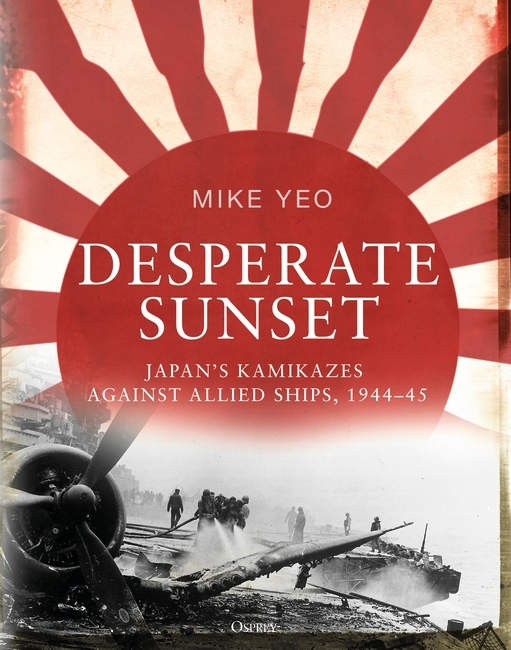By the middle of 1944, in a last desperate bid to stave off defeat, Japan’s High Command launched the terrifying kamikaze attacks. These attacks are the subject of Mike Yeo's new book Desperate Sunset. Read on to find out more.
The fanaticism of the Japanese military during the war in the Pacific is well known by anyone with even a passing interest in the genre, and if anything, this fanaticism only grew as Imperial Japan was forced back on all fronts in 1944.
Despite this reputation, the use of tokko (“special attack”) tactics soon after American forces invaded the Philippines in October 1944 was still a nasty surprise. Unbeknownst to the US, Imperial Japan had started formulating plans for its pilots and aircraft to fly one-way missions and deliberately crash bomb-laden aircraft onto enemy ships as early as the middle of 1944, and in mid-October had started organizing dedicated units for such a purpose.
The driving force for these tactics, in addition to the increasingly terrible military situation the Japanese found themselves in, was the sharp decline in pilot quality. Even by 1943, the ranks of Imperial Japan’s painstakingly trained pilots had been ground down by the war of attrition in the Solomons and New Guinea, and the training pipeline could not replace them either in terms of quantity or of quality.
The first successes of the tokko – more popularly known as the kamikaze (Divine Wind, named after the typhoons that destroyed separate Mongol invasion fleets bound for Japan in the 13th century) – came on October 25 in the immediate aftermath of the Battle of Leyte Gulf and about five days after the first missions were flown.
That morning, an American escort carrier (USS St Lo) was sunk and several others damaged, and this heralded a whole new way of war for the Japanese. From that day until the attacks ended with the final Japanese surrender in August 1945, Japan launched hundreds of tokko attacks, sinking and damaging some 300 Allied ships and killing thousands of Allied seamen.
The book
This is not the first English-language book detailing the Japanese tokko campaign against Allied ships in the last ten months on the war. However, the key difference is that Desperate Sunset looks at both Allied and Japanese sources in an attempt to get a fuller account of the campaign.
In addition to using the war diaries, action reports and anti-aircraft reports of US Navy ships attacked by the “Special Attackers,” as well as the after-action reports of the Allied pilots who defended their ships, we will also look at published Japanese lists of Tokubetsu Kogekitai (Special Attack Units), the aircraft they used, and rosters of pilots who were sent on these one-way missions off the Philippines, Formosa, Okinawa and Japan.
The book will also look into some of the lesser-known tokko attacks of the war, such as the attack on the Allied invasion fleet off Balikpapan in the Dutch East Indies on June 25, 1945, as well as the sinking of the British minesweeper HMS Vestal off Phuket in Siam (Thailand) one month later by a Malaya-based tokko unit.
Most importantly, this book cross-references Japanese data with Allied reports in an attempt to shed more light on tokko attacks and reconcile them with Allied reports. During the course of researching the material for the book, it was found that the attackers were wrongly identified by eyewitnesses in many cases. This is understandable, given that identifying aircraft in the heat of battle, especially when confronted with types seldom encountered by Allied seamen, was challenging at best) With the Japanese sources on hand, an attempt can be made to try to correct the record, as can be seen in this excerpt from the book about the attack on the destroyer-escort USS LeRay Wilson off the Philippines on January 10, 1945.
“…the destroyer-escort USS LeRay Wilson (DE-414) was on anti-submarine patrol off the western entrance of the Lingayen Gulf when its crew spotted a twin-engined bomber emerging out of the gloom of the western sky. The ship had little time to react, for the bomber was first observed just 1,000 yards off its port bow, approaching from almost dead ahead and flying just above the surface of the sea. Identified as a ‘Betty,’ this was most likely the modified To-Go ‘Peggy’ bomber flown by Captain Kunio Soga of the Fugaku-tai that taken off from Clark Field at 0400hrs.
“To its crews’ credit, the LeRay Wilson responded admirably to the threat, despite its close proximity. Quickly engaging the bomber with antiaircraft fire, they scored several hits and set its port wing aflame, causing the pilot to veer off his intended flightpath. The last detail was crucial for securing the survival of the 1,350-ton warship, for it would have been unlikely to have survived a direct hit from the explosive-packed ‘Peggy.’ Instead, the bomber’s wing clipped the two 20mm mounts on the portside amidships and plunged into the sea beyond. The broken wing released burning fuel onto the exposed surfaces of the ship and started a fire that took several hours to contain, although the vessel was never in any danger of sinking and was underway again by 1000hrs. Eight crewmen were killed and three others lost at sea, with two more wounded.”
It is hoped that Desperate Sunset will invite a fresh look at this aspect of the Pacific campaign, and continue the increasing recent trend of using published Japanese data and available archives to try and paint a fuller, more accurate, picture of the war in the Pacific by reconciling that with available information from the Allied side.
Desperate Sunset publishes today. Get your copy from the website here.


Comments
You must be logged in to comment on this post. Click here to log in.
Submit your comment